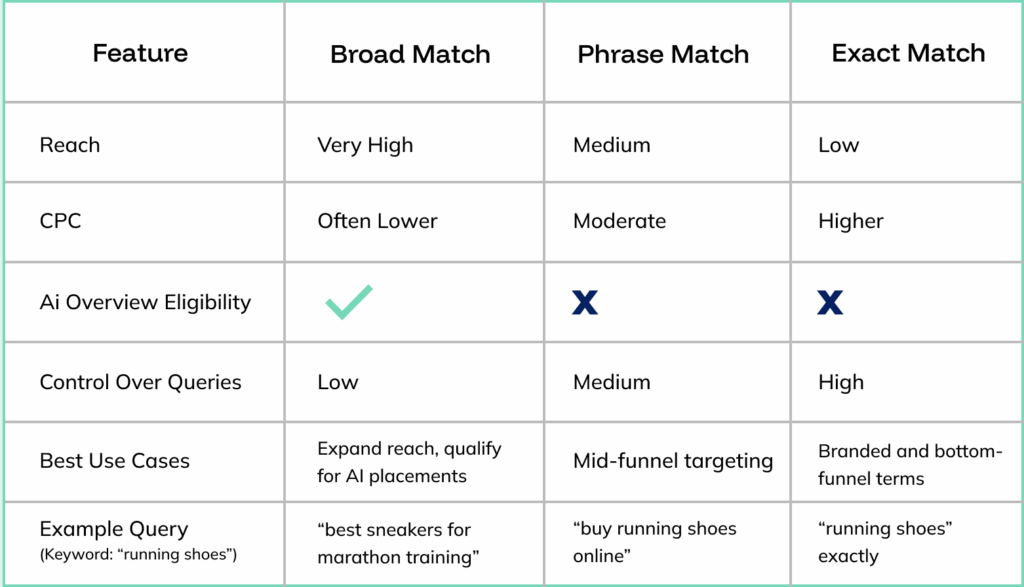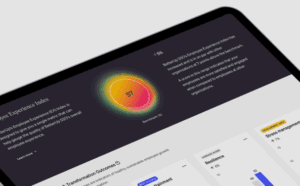Home / Blog / Broad Match Google Ads: Benefits, Best Practices, and AI Visibility
AI Ai overviews AI visibility broad match chatgpt digital marketing Google Paid Media
Broad Match Google Ads: Benefits, Best Practices, and AI Visibility

Published: September 19, 2025
Share on LinkedIn Share on Twitter Share on Facebook Click to print Click to copy url

Contents Overview
Why Broad Match Matters in Paid Search
Broad match used to be the “boogeyman” of Google Ads. Advertisers avoided it because it felt unpredictable and expensive compared to exact or phrase match. That mindset could now be limiting your performance.
Today, Google Ads has changed with AI-driven search. Broad match is no longer risky guesswork. It is one of the smartest ways to expand reach, reduce CPCs, and unlock ad placements that phrase and exact keywords cannot touch, like AI Overview and AI Mode ads.
Broad match is the only match type that leverages unique signals such as:
- Landing pages
- Other keywords in the ad group
- Previous searches
- User location
Because it is powered by Google’s large language models, broad match now understands searcher intent at a much deeper level.
What You Gain With Broad Match Keywords
Broad match delivers benefits that go beyond efficiency:
- Expanded reach: Capture synonyms, long-tail queries, and related terms automatically.
- Lower CPCs: Many advertisers see cheaper clicks compared to exact or phrase.
- Higher-intent traffic: Long-tail searches often convert at stronger rates.
- Proven lift: Google reports advertisers gain +13% more conversions or conversion value at a similar CPA/ROAS when broad match is used with smart bidding.
- AI visibility: Broad match is required for showing ads in AI-powered experiences like AI Overview and AI Mode.
Other campaign types such as Performance Max and Shopping also qualify for AI surfaces, but broad match is the only keyword-based path.
Broad Match vs Exact Match vs Phrase Match

How to Make Broad Match Work (Best Practices and Guardrails)
Broad match can drive impressive results, but only with the right guardrails in place.
✅ Broad Match Checklist Before Launch
- Pair with exact match keywords.
- Use smart bidding (Max Conversions, tROAS).
- Monitor search terms weekly.
- Add negative keywords.
- Test with Google Ads Experiments.
- Apply brand inclusions in brand campaigns.
Use Broad Match Alongside Exact Match Keywords
- Do not replace exact match, run them together.
- Exact maintains campaign structure and takes priority.
- Broad fills in gaps and captures incremental searches.
Pair Broad Match With Value-Based Bidding
- Manual bidding does not work here.
- Use smart bidding: Max Conversions, Max Conversion Value, tROAS, or tCPA.
- Keeps campaigns focused on conversions and revenue, not vanity clicks.
Monitor Search Terms and Add Negative Keywords
- Review search term reports regularly.
- Add negatives to exclude irrelevant or low-value traffic.
- Use broad as a keyword discovery tool: promote high-performing queries into exact match campaigns.
Test Broad Match With Google Ads Experiments
- Run a 50/50 split test:
- Control = exact/phrase only
- Test = broad added in
- Measure CPC, CTR, CVR, conversions, and ROAS.
- Broad does not need to be your most efficient match type. Its role is to expand reach without lowering overall campaign efficiency.
Pitfalls to Avoid
- Launching broad without automated bidding.
- Neglecting search term reports.
- Using broad in niche campaigns with small keyword sets.
- Running brand campaigns without Brand Inclusions.
When Broad Match Works Best
Broad match is not right for every campaign. Here is where it shines:
- Non-brand campaigns: Expands reach beyond your exact match core.
- High-volume verticals: Retail, education, SaaS, and healthcare tend to benefit.
- Top- and mid-funnel strategies: Captures searches from people who do not know your brand yet.
- AI-focused advertisers: Essential for visibility in AI Overview and AI Mode ads.
Broad Match and AI Search Visibility
This is where broad match becomes a competitive advantage.
- Broad match is the only match type eligible for AI Overview and AI Mode placements.
- Phrase and exact keywords will not qualify for these new surfaces.
- Brands that ignore broad risk being invisible in AI-driven search results.

Case Study
YTD, Broad Match keywords in non brand campaigns for a Furniture client:
- Broad Match CVR is 10% higher than CVR from Exact match and 75% higher than CVR from Phrase match.
- Broad match ROAS is similar compared to Exact Match and is 25% higher than Phrase match keywords.
- Broad match spent 9% less than Phrase match has, but has generated 31% more conversions.
- Broad match has had a 2% lower CPC than Exact Match keywords.
Another client has been testing Broad match for about a month. We are running an experiment where the test campaign includes Broad match + Exact match, while the control campaign is only using Exact match. There have been wins comparing the test campaign to the control campaign and comparing Broad match to Exact match.
- The campaign using Broad Match + Exact Match has a 35% higher CVR, 116% more conversions, and a 17% higher ROAS.
- Broad Match CPC is 16% lower than Exact match in the same campaign.
- Broad Match has driven 198% more conversions due to a 126% higher CVR.
Broad Match FAQs
Q: Should I replace exact match with broad match?
No. Broad should complement exact, not replace it.
Q: Can broad match work without automated bidding?
No. Broad requires value-based smart bidding to maintain quality traffic.
Q: Does broad match work in all industries?
Not always. Niche accounts may not see as much benefit, but it is still worth testing.
Q: How do I measure success with broad match?
Focus on conversions, CVR, revenue, and ROAS, not CTR.
Q: How long should I run a broad match experiment?
At least 4–6 weeks to gather statistically valid data.
Q: Does broad match work internationally?
Yes, but performance may vary depending on language and search patterns.
Q: How does broad match compare to Dynamic Search Ads (DSA)?
DSA targets based on website content, while broad is still keyword-based. They can work together for incremental reach.
Ready to Test Broad Match in Your Campaigns?
Broad match has evolved. With the right setup, it can:
- Expand your reach at lower CPCs.
- Unlock placements in Google’s AI-powered search experiences.
- Drive incremental conversions while supporting exact match.
Don’t let your competitors take the lead in AI search. Get a Paid Search Audit from Go Fish Digital

About Thomas Delsignore
MORE TO EXPLORE
Related Insights
More advice and inspiration from our blog
Why AI Makes Product Feed Optimization Critical for Google Shopping
AI is transforming Google Shopping. Learn why optimized product feeds are...
Logan Durant| October 16, 2025
Standard Shopping vs Performance Max: When to Use Each in Google Ads
Performance Max is powerful, but not always the right fit. Learn...
Brian ONeil| October 01, 2025
Negative Keywords in Google Ads: The Key to Scalable Campaigns
Learn how negative keywords improve Google Ads performance. Build master lists,...





